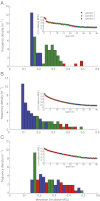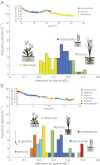Vegetation engineers marsh morphology through multiple competing stable states
- PMID: 23401529
- PMCID: PMC3587243
- DOI: 10.1073/pnas.1218327110
Vegetation engineers marsh morphology through multiple competing stable states
Abstract
Marshes display impressive biogeomorphic features, such as zonation, a mosaic of extensive vegetation patches of rather uniform composition, exhibiting sharp transitions in the presence of extremely small topographic gradients. Although generally associated with the accretion processes necessary for marshes to keep up with relative sea level rise, competing environmental constraints, and ecologic controls, zonation is still poorly understood in terms of the underlying biogeomorphic mechanisms. Here we find, through observations and modeling interpretation, that zonation is the result of coupled geomorphological-biological dynamics and that it stems from the ability of vegetation to actively engineer the landscape by tuning soil elevation within preferential ranges of optimal adaptation. We find multiple peaks in the frequency distribution of observed topographic elevation and identify them as the signature of biologic controls on geomorphodynamics through competing stable states modulated by the interplay of inorganic and organic deposition. Interestingly, the stable biogeomorphic equilibria correspond to suboptimal rates of biomass production, a result coherent with recent observations. The emerging biogeomorphic structures may display varying degrees of robustness to changes in the rate of sea level rise and sediment availability, with implications for the overall resilience of marsh ecosystems to climatic changes.
Conflict of interest statement
The authors declare no conflict of interest.
Figures

 is comprised between
is comprised between  and
and  , the elevation will tend toward
, the elevation will tend toward  . If the initial elevation of the site at
. If the initial elevation of the site at  is located below
is located below  , the elevation will tend toward
, the elevation will tend toward  .
.
 (for each site xk and each time step), generating relatively noisy patterns. However, the multimodal frequency distribution of topographic elevation, the signature of the underlying biogeomorphic coupling, remains detectable. Each peak (color coded according to the species that is most abundant within each elevation interval) clearly is associated with the unique species that generates it. (B) In the absence of an organic soil contribution to the accretion rate, the resulting smooth topography is determined entirely by inorganic deposition. Vegetation species colonize the transect in banded patterns according to their respective fitnesses. (C) The frequency distribution of topographic elevation shows uncertain symptoms of multiple peaks when less specialized vegetation species (λ = 2) are considered, a sign that a decreased vegetation specialization produces less easily detectable multiple peaks in the topographic elevation frequency distribution.
(for each site xk and each time step), generating relatively noisy patterns. However, the multimodal frequency distribution of topographic elevation, the signature of the underlying biogeomorphic coupling, remains detectable. Each peak (color coded according to the species that is most abundant within each elevation interval) clearly is associated with the unique species that generates it. (B) In the absence of an organic soil contribution to the accretion rate, the resulting smooth topography is determined entirely by inorganic deposition. Vegetation species colonize the transect in banded patterns according to their respective fitnesses. (C) The frequency distribution of topographic elevation shows uncertain symptoms of multiple peaks when less specialized vegetation species (λ = 2) are considered, a sign that a decreased vegetation specialization produces less easily detectable multiple peaks in the topographic elevation frequency distribution.
References
-
- Adam P. Saltmarsh Ecology. Cambridge, UK: Cambridge Univ Press; 1990.
-
- Allen JRL. Morphodynamics of Holocene salt marshes: A review sketch from the Atlantic and Southern North Sea coasts of Europe. Quat Sci Rev. 2000;19:1155–1231.
-
- Blum LK, Christian RR. The Ecogeomorphology of Salt Marshes. 2004. Belowground production and decomposition along a tidal gradient in a Virginia salt marsh. Coastal and Estuarine Studies (American Geophysical Union, Washington, DC), Vol 59, pp 47–74.
-
- D’Alpaos A, Mudd SM, Carniello L. Dynamic response of marshes to perturbations in suspended sediment concentrations and rates of relative sea level rise. J Geophys Res. 2011;116:F04020.
-
- Marani M, D’Alpaos A, Lanzoni S, Carniello L, Rinaldo A. Biologically-controlled multiple equilibria of tidal landforms and the fate of the Venice lagoon. Geophys Res Lett. 2007;34(11):L11402.
Publication types
MeSH terms
Substances
LinkOut - more resources
Full Text Sources
Other Literature Sources
Molecular Biology Databases

